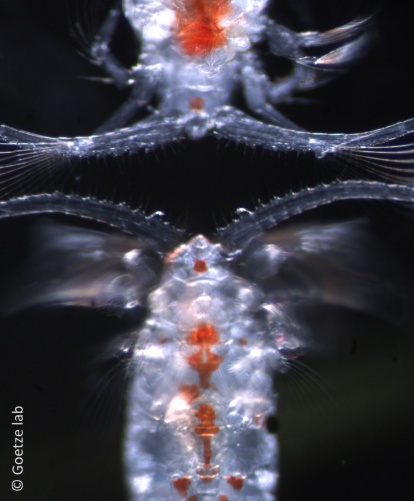 And here is one of them. This beautiful reddish copepod is also in the genus Pleuromamma, and does not yet have a scientific name. I show this for those of you who don’t yet know that the ocean is a mysterious and relatively uncharacterized place, with lots of secrets left to uncover. Despite a decade of discovery in the international Census of Marine Life, there are still many marine species left to be discovered and described. For some faunal groups, the majority of the species present may be new to science. We tend to think of marine zooplankton as being relatively well studied, in comparison to the deep sea. However, even for surface zooplankton, I suspect that the majority of species may be undescribed in high diversity ocean regions, such as the subtropical gyres. Learning about this diversity is critically important to understanding how these communities function, and the role different species play in marine food webs.
And here is one of them. This beautiful reddish copepod is also in the genus Pleuromamma, and does not yet have a scientific name. I show this for those of you who don’t yet know that the ocean is a mysterious and relatively uncharacterized place, with lots of secrets left to uncover. Despite a decade of discovery in the international Census of Marine Life, there are still many marine species left to be discovered and described. For some faunal groups, the majority of the species present may be new to science. We tend to think of marine zooplankton as being relatively well studied, in comparison to the deep sea. However, even for surface zooplankton, I suspect that the majority of species may be undescribed in high diversity ocean regions, such as the subtropical gyres. Learning about this diversity is critically important to understanding how these communities function, and the role different species play in marine food webs.
 This beautiful Pleuromamma copepod is distinct from both P. abdominalis and P. quadrungulata, with which it co-occurs here in the equatorial region. It has long been noted that there is variation in the presence and degree of development of spines on the antennules of Pleuromamma copepods. In the photo, you can see two animals, oriented head to head, with the top animal lacking the strong spines on the antennules that are very visible in the animal below. It turns out that this variation is informative, and can be used to distinguish good species. Stay tuned for an upcoming publication from Junya Hirai (University of Tokyo) on the genetic lineages within the ubiquitous species P. abdominalis. I hope to find the time to establish a name for this organism, along with the many other undescribed lineages within this nominal species. Establishing a new name for a species is an opportunity to honor your predecessors and acknowledge the heroes that inspired your scientific journey. I hope to name at least one of these species P. frosti, in honor of Bruce Frost.
This beautiful Pleuromamma copepod is distinct from both P. abdominalis and P. quadrungulata, with which it co-occurs here in the equatorial region. It has long been noted that there is variation in the presence and degree of development of spines on the antennules of Pleuromamma copepods. In the photo, you can see two animals, oriented head to head, with the top animal lacking the strong spines on the antennules that are very visible in the animal below. It turns out that this variation is informative, and can be used to distinguish good species. Stay tuned for an upcoming publication from Junya Hirai (University of Tokyo) on the genetic lineages within the ubiquitous species P. abdominalis. I hope to find the time to establish a name for this organism, along with the many other undescribed lineages within this nominal species. Establishing a new name for a species is an opportunity to honor your predecessors and acknowledge the heroes that inspired your scientific journey. I hope to name at least one of these species P. frosti, in honor of Bruce Frost.
Keep in mind that even though we are now out in the middle of the Atlantic Ocean, you don’t have to go very far to find new species. You may even have some right in your backyard. For example, I know there are some undescribed copepods in the coral rubble right along the beach at Diamond Head, at one of the most popular surfing spots on Oahu (my backyard at home in Honolulu). There are probably also a myriad of small, but important, and unknown species lurking in the habitats around your home. Find them and be amazed!

My eyes are not good enough for such a discovery.
But I enjoy reading your enthousiastic blog.
Kind regards,
LikeLike